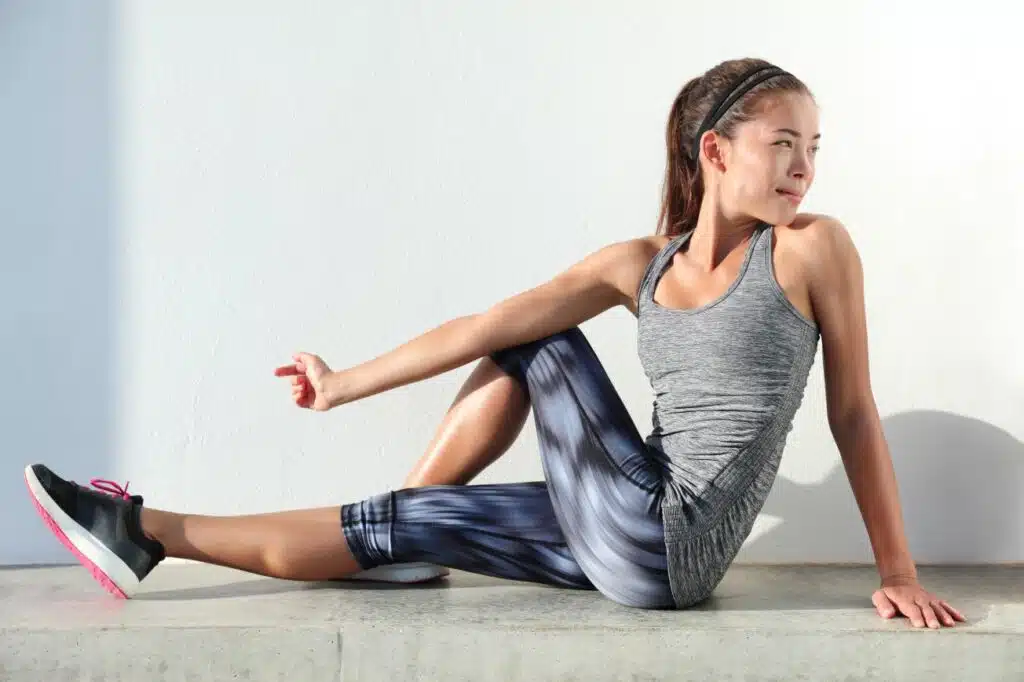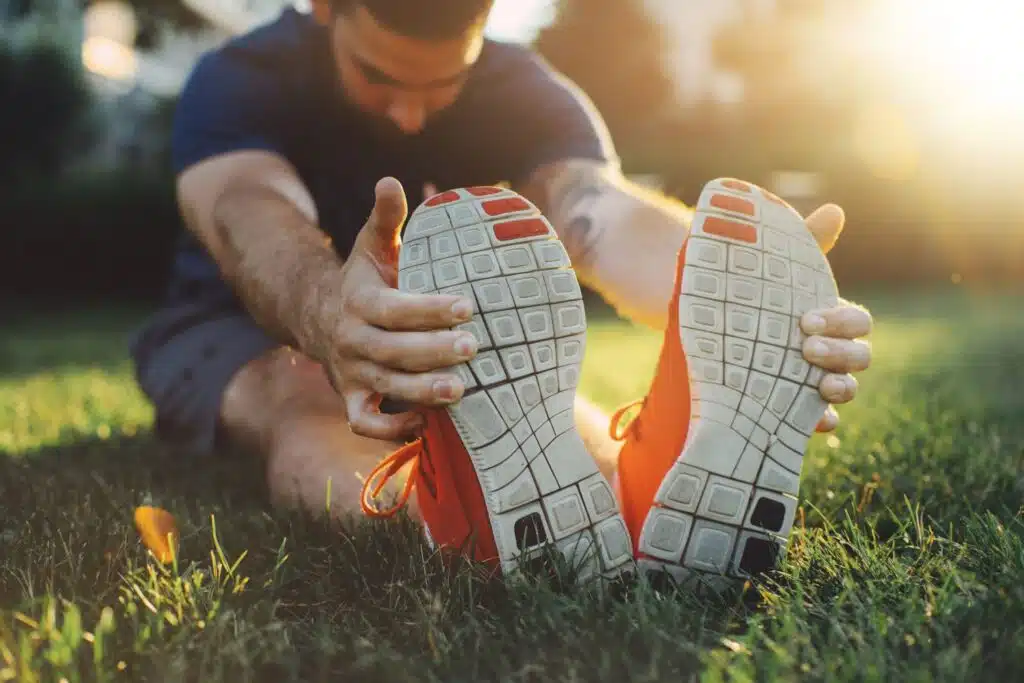Most people have learned over the years that flexibility plays a crucial role in enhancing the body’s effectiveness in movement, priming it for exercise, and serving as a preventative measure against injuries. However, flexibility training often gets overlooked and is easily skipped when time is tight in a workout routine. But how much does having good flexibility help runners?
Consider this: when running, certain muscles undergo shortening, facilitating a more efficient stride and consequently, faster running. Picture these muscles as rubber bands, their tautness providing added energy for propulsion. Old stretched-out loose rubber bands cannot snap back and don’t add anything. Overly tight rubber bands are more prone to snap. For runners, striking the right balance in flexibility is key. Excessive flexibility can compromise running efficiency, while insufficient flexibility may heighten injury risks. Striking a balance between the advantages and drawbacks of stretching is imperative for runners.

How can poor flexibility lead to an increased risk of injury?
The lack of flexibility in runners can increase the risk of injury in runners due to several factors including having limited range of motion, muscle imbalances, decreased shock absorption, limited recovery ability and compromised biomechanics
When the body cannot move through its full range of motion, compensatory movements occur, placing excessive stress on certain muscles, tendons, and ligaments. Tight muscles and inflexible joints cannot effectively absorb the forces generated with each foot strike.
Flexibility plays a role in muscle recovery and regeneration post-exercise. Tight muscles recover more slowly and are prone to micro-tears, scar tissue and inflammation. Without adequate flexibility, the body may struggle to recover fully between runs, increasing the likelihood of overuse injuries and chronic conditions.
Muscle imbalances occur when certain muscle groups are overactive and tight while others are weak and underactive. These imbalances can lead to poor biomechanical alignment and dysfunctional movement patterns, increasing the risk of injury. Flexibility is essential for maintaining proper biomechanical alignment during running. When muscles and joints are tight, the body may adopt compensatory movement patterns to accommodate the lack of flexibility.
Each of these issues can lead to a variety of overuse injuries and other conditions, such as shin splints, IT band syndrome, stress fractures, tendonitis, plantar fasciitis, bursitis, and muscle strains.
How Much Flexibility Does a Runner Need?
At a bare minimum, you need to be able to separate your feet enough to get a proper running stride. That is really all you need for running in and of itself. I always tell my patients who are runners that they don’t need to be able to kick anyone in the head, so flexibility is not the most important thing. That being said, you also need to be able to live your life. You need to be able to sit down comfortably. You should be able to bend over to properly pick something off the ground. You should be able to get into a deep squat and take 2 stairs at a time if you want. It is not imperative for all runners to be able to touch their toes or squat down and touch their butt to the ground, but picking up a dropped pencil should not be a whole ordeal.
An interesting measurement of balance, flexibility, and strength that you can try is the sit-rise test. In this test, you attempt to get onto the ground into a sitting cross-legged position and back off of the ground by only touching the ground with your buttocks and feet. Using your hands, forearm, elbow, or knee is cheating. It is a challenge for sure. Some say that the ability to do it is connected to your longevity, but the research is not concrete.

Flexibility’s Effect on Running Economy
Successful distance running relies on the ability of the heart and lungs to supply the body with oxygen and nutrition (VO2 Max), the ability to sustain oxygen use over long periods of time and efficient movement. Running using efficient movement without having energy leaks would be good running economy.
A runner with good running economy requires less oxygen and energy to sustain a given pace compared to a runner with poor running economy. Factors influencing running economy include biomechanics, muscle efficiency, aerobic fitness, neuromuscular coordination, metabolic efficiency, and experience.
Improving running economy is a key focus for many runners as it can lead to better performance, allowing them to run faster or longer while expending less energy. Trained runners generally have better running economy than less trained ones, thanks to their regular practice. Training interventions such as strength training, plyometrics, running form drills, and aerobic conditioning can all contribute to enhancing running economy. Additionally, factors such as optimal footwear selection, running surface, and environmental conditions can also impact running economy.
There is debate about whether flexibility affects running economy. Some studies suggest that less flexibility is linked to better running economy. The idea is that runners with tighter muscles and tendons tend to store more elastic energy in their legs that can be translated into forward motion. However, stretching shouldn’t be ignored as it’s commonly used to prevent injuries and improve stride length. The bottom line for me is that I would not encourage an elite runner to drastically improve their flexibility because they would lose their stiffness and get slower because of the change in their running economy.

Managing Existing Injuries with Stretching
Stretching also proves beneficial in managing prevalent injuries. Plantar fasciitis is a common ailment causing heel pain, where tight calf muscles contribute to this condition. Regularly stretching the three major muscles in the calf is one of the therapies that I prescribe to treat and resolve plantar fasciitis. This can be injury-specific though as time might be better spent on strengthening weaker muscles than stretching tightness, as would be the case with ITB syndrome.
Care should always be taken with a new injury since stretching can often make the problem worse. Proper stretching can put excess loads on the tissues so a fresh muscle strain would not be a good thing to stretch. Proper recovery and treatment followed by starting gentle stretching after around a week could be appropriate. Even then, you should not feel sharp pain in the injured area when it is stretched.

Good Flexibility Practices for Runners
There is a difference between dynamic stretching, which can be included as part of a warm-up, and static stretching which might be done post-workout as part of your regular maintenance. Static stretches involve holding a stretch position for a period of time that should always be more than 20 seconds and more typically 30 to 60 seconds. I recommend a 60-second hold time when recovering from injury or attempting to improve flexibility and a 30-second hold time when attempting to maintain your current flexibility. Most runners should be able to do maintenance stretches after a run as part of a cool-down after each run with the stretching lasting less than 10 minutes. You need to remember to listen to your body and whether your discomfort is actually pain.
Since everyone starts from a different place and has different goals regarding health, you may want to stretch more or less. Someone running 6 days a week might only need to stretch 4 days a week. There are differences between someone whose sole focus is running and someone who likes to run and teach yoga.
Conclusion
Flexibility is integral to running performance and injury prevention, yet striking the right balance is key. Inadequate flexibility heightens injury risks due to limited range of motion, muscle imbalances, and compromised shock absorption. Poor flexibility also impedes muscle recovery and can lead to overuse injuries. However, excessive flexibility may compromise running efficiency. Good flexibility practices include dynamic stretching for warm-ups and static stretching for maintenance, tailored to individual needs and running frequency. Ultimately, finding the right balance between flexibility and strength is essential for optimal running performance and overall health.
